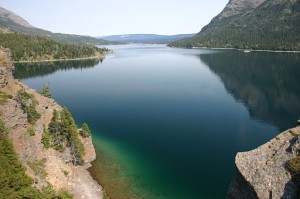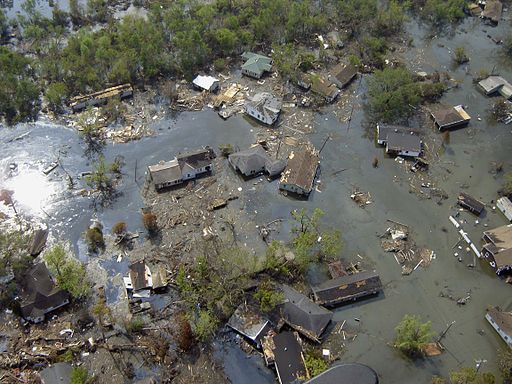
St. Mary Lake at Sun Point, Glacier National Park, Montana, USA. Photo courtesy of Wing-Chi Poon, Wikimedia Commons.
As we discussed in this issue’s science content knowledge article, Essential Principle 7 states that climate change will have consequences for the earth system and human lives. These consequences include sea-level rise and coastal flooding, reduced reliable access to freshwater for people around the world, increased numbers of extreme weather events, increasingly acidic ocean water, shifts in ecosystems and migration patterns, and increased incidents of climate-sensitive infectious diseases. These are serious consequences and, as written, are not appropriate for inclusion in elementary science. Instead, we advocate teaching about some of these phenomena in general, without tying them to climate change.
We’ve highlighted lessons about the availability of freshwater worldwide and extreme weather events. If students leave the elementary grades knowing that freshwater is a limited resource and understanding how and why extreme weather events occur, they will be well poised to understand the consequences of climate change in later grades.
Water Availability
Consider pairing lessons about water availability with those about the water cycle. Find water cycle lessons in the article The Water Cycle and the Polar Regions: Hands-on Science and Literacy and in the article Setting the Stage for Understanding the Climate System’s Complex Interactions.
Water Scarcity (Grades K-2)
This activity helps students visualize the limited amount of freshwater available around the globe. Students also brainstorm ways to reduce their own water usage. This activity aligns with the Science in Personal and Social Perspectives content standard (Grades K-4) of the National Science Education Standards.
Water Scarcity (Grades 3-5)
A more advanced version of the K-2 activity listed above, this activity also helps students visualize the limited amount of freshwater available around the globe. Students also work cooperatively to research water use in countries around the world. This activity aligns with the Science in Personal and Social Perspectives content standard (Grades K-4 and 5-8) of the National Science Education Standards.

Port Sulphur Louisiana after Hurricane Katrina, extensive residential damage and flooding. Photo courtesy of NOAA, Wikimedia Commons.
Extreme Weather Events
What Is a Tornado? (Grades K-2)
In this lesson, students will learn the basics about how tornadoes are formed, and when and where they are most likely to occur. They will learn that the United States is the country most vulnerable to tornadoes and why most tornadoes occur in “tornado alley.” Students will “create” a tornado in a bottle. Finally, they will draw pictures of tornadoes of different shapes and sizes and review basic safety information about what to do in a tornado. This lesson aligns with the Earth and Space Science content standard (Grades K-4) of the National Science Education Standards.
Prepare Yourself! (Grades K-2)
This lesson introduces U.S. students to natural hazards that occur across their country and in their home region. Students will learn where tornadoes, hurricanes, earthquakes, volcanoes, or severe thunderstorms are likely to occur and will find out which type of event is most likely to happen near their home. They will practice some safety steps and will make signs to educate other kids and adults about these precautions. This lesson aligns with the Science in Personal and Social Perspectives content standard (Grades K-4) of the National Science Education Standards.
Dust Bowl Days (Grades 3-5)
This cross-curricular lesson introduces students to the Dust Bowl through photographs, songs, and interviews with people who lived through it. The lesson aligns with the Life Science and Science in Personal and Social Perspectives content standards of the National Science Education Standards.
Hurricanes 1: The Science of Hurricanes (Grades 3-5)
In an effort to begin to understand the nature of motion — particularly how changes in speed or direction of motion are caused by forces, students examine different scientific aspects of hurricanes. This lesson is the first of a two-part series on the science of hurricanes and the kinds of technology being used to identify and track them. This lesson aligns with the Earth and Space Science content standard (grades K-4 and 5-8) of the National Science Education Standards.
The Eye of the Hurricane (3-5)
This lesson introduces students to the structure of a hurricane, particularly the eye. You might want to use it as an introduction to a unit on hurricanes or weather phenomena. Students will view a video about hurricanes, do a simple hurricane simulation, take a tour into the eye of a hurricane, and write reports about their tour. This lesson aligns with the Earth and Space Science content standard (grades K-4 and 5-8) of the National Science Education Standards.
This article was written by Jessica Fries-Gaither. Jessica is an education resource specialist at The Ohio State University and project director of Beyond Weather and the Water Cycle and Beyond Penguins and Polar Bears. She has taught in elementary and middle school settings. Email Jessica at beyondweather@msteacher.org.
Copyright February 2012 – The Ohio State University. This material is based upon work supported by the National Science Foundation under Grant No. 1034922. Any opinions, findings, and conclusions or recommendations expressed in this material are those of the author(s) and do not necessarily reflect the views of the National Science Foundation. This work is licensed under an Attribution-ShareAlike 3.0 Unported Creative Commons license.



